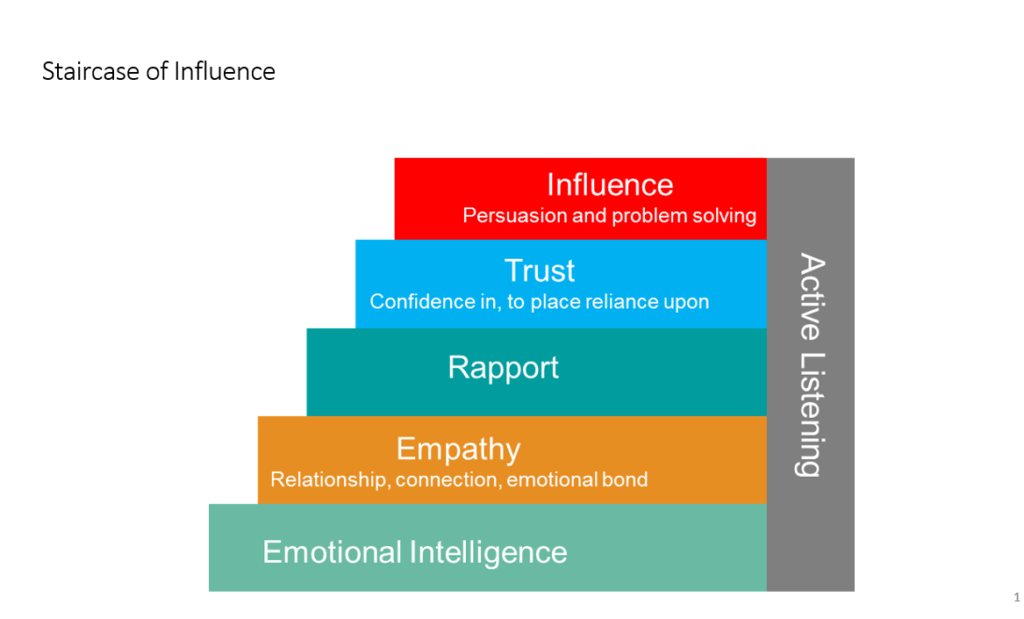The staircase to influence
The staircase to influence
5 minutes

The Behavioral Change Stairway Model was developed by the FBI’s hostage negotiation unit to help individuals influence others, particularly in high-stakes situations. While initially created for crisis negotiation, it is not limited to scenarios involving barricaded criminals with assault rifles; it applies to almost any form of disagreement or differing viewpoints.
Often, people attempt to influence others by talking, but listening is actually more powerful. This is why listening is emphasised at every step of the model.
In any negotiation, people seek two outcomes: achieving their goals and maintaining the relationship. Although challenging, it can be accomplished by effectively leveraging influence and emotion.

The staircase to influence has been adapted to a business context and structured around five progressive stages: Active Listening, Empathy, Rapport, Trust and Influence. Each stage builds upon the previous one, creating a stairway that, when ascended step by step, leads to a greater ability to influence.
This is the foundation of the staircase where the focus is on truly hearing and understanding the other person’s words, tone, and non-verbal cues. The problem is, that most people are terrible at listening. Many of us are more focused on what we want to say next rather than truly absorbing what the other person is communicating. For this to work, you need to pay full attention and acknowledge the other person’s feelings. Active listening can help in diagnosing issues and concerns, demonstrating respect and openness, and most importantly, making the other side feel heard.
Stepping up from listening to empathy involves recognising and validating the emotions and perspectives of others. You get an understanding of where they’re coming from and how they feel. You get an understanding of their perspective and feelings. This has to be achieved in a genuine and authentic tone, noting that you don’t have to agree with their perspective to show understanding. Empathy helps build trust, as individuals feel understood and valued. Showing empathy can de-escalate tensions and pave the way for constructive conversations.
Empathy is what you feel. Rapport is when they feel it back. Look at their body language – they might lean in, nod at what you are saying, smile. They start to trust you. This involves positive reframing and exploring common ground. Building rapport is about creating a connection and a sense of mutual understanding. It is the stage where relationships are strengthened, and a collaborative spirit is fostered.
This involves a consistent experience of competence, integrity, transparency, commitment to purpose. Once they trust you, you’ve earned the right to express your point of view and work on problem-solving with them and recommend a course of action.
They act. (And maybe come out with their hands up.) This involves behavioural change. It allows you to explore potential and create realistic solutions and likely alternatives. This change is often a result of a well-nurtured process where the previous stages have effectively aligned the motivations and actions of individuals with the desired outcomes.
Trying to skip stages in the model often leads to ineffective communication and failed influential outcomes. For example, attempting to exert influence without first establishing empathy and rapport can come across as insincere or too directive. Without empathy, the other person may feel that their emotions and perspectives are not heard. People are generally less receptive to influence when they feel misunderstood or unheard, so you might not get the influence that you want.
Each stage of the staircase to influence is there for a reason, and skipping any of them derails the whole process. Active listening ensures you fully understand the other person’s perspective. Empathy shows you care about their feelings. Rapport builds a connection. Influence aligns goals and motivations, which builds trust and later on influence.
Hellomonday